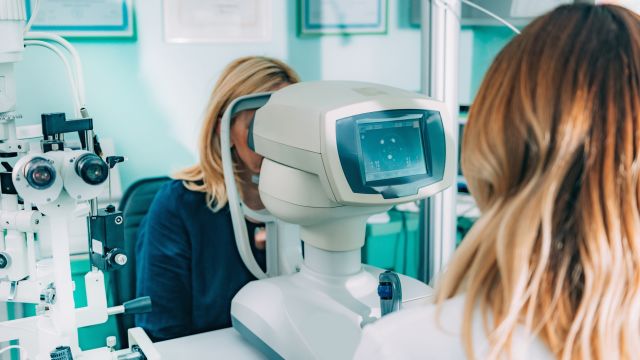Updated on December 14, 2023
Diabetic macular edema (DME) is a diabetes complication that affects a part of the eye called the macula. The macula is a dense cluster of light sensitive cells located in the back of the eyeball. It is part of the retina, a layer of light-sensitive cells in the back of the eye that acts as a bridge between the eyeball and the nervous system.
DME causes the macula to fill with fluid and swell. Swelling and fluid in the macula disrupts central vision—the ability to see objects and details directly in front of the eyes.
DME is a complication of diabetic retinopathy
DME occurs as a complication of diabetic retinopathy, a common form of diabetic eye disease.
In simple terms, diabetic retinopathy can be described as damage to the blood vessels in the retina. Uncontrolled high blood glucose levels (high blood sugar), high blood pressure, and high cholesterol levels can all contribute to diabetic retinopathy. Smoking and having diabetes for a long time are other risk factors.
Diabetic retinopathy causes blood vessels to leak blood and fluid into the eye. In the early stages, this may cause no noticeable symptoms. In the more advanced stages, symptoms may include a number of vision changes—floaters, blurriness, dark areas in vision, poor night vision, colors appearing dulled. Diabetic retinopathy can also cause vision loss and blindness, even when it doesn’t lead to DME.
DME can occur at any stage of diabetic retinopathy. However, the risk is greater when diabetic retinopathy is advanced.
Proliferative diabetic retinopathy
Another term to know is proliferative diabetic retinopathy. This is an advanced type of diabetic retinopathy. It occurs when the eye begins to grow new blood vessels in and around the retina. This is considered the most advanced stage of this condition. The new blood vessels form as the body tries to repair the damage caused by diabetes. However, the new blood vessels do not function well—they are leaky and easily damaged.
Managing DME and diabetic retinopathy
Controlling diabetes—including A1C (a blood glucose measurement), blood pressure, and cholesterol—are an important part of treatment for DME and diabetic retinopathy. This is sometimes referred to as the diabetes ABCs. Controlling these numbers can help slow the progression of vision problems and help a person get more from the other parts of their treatment plan.
What are the other parts of a treatment plan?
The most commonly used treatment for DME is anti-VEGF therapy. This is a medication that is injected into the eye to block a protein called vascular endothelial growth factor (VEGF). The eye is numbed during the injection, and the process is typically painless.
VEGF is a protein that helps repair and maintain the structure of blood vessels. In excess amounts, VEGF will damage blood vessels, causing them to leak. Excess VEGF is not the only mechanism that damages the blood vessels of the eye when a person has diabetic retinopathy and DME, but it is a significant factor—and blocking VEGF helps stop blood vessels from leaking.
Again, diabetes control plays an important role—high blood glucose levels trigger the production of excess VEGF (as well as various inflammatory proteins). Keeping blood glucose controlled can help prevent this from happening.






